#Copper Development Association
Explore tagged Tumblr posts
Text





CDA Electric Town Car, 1975. The Copper Development Association Inc. we very active in the promotion of the use of copper in the automotive industry. They built a series of prototypes including this city car that was designed from the ground up to be electrically powered.
#CDA#Copper Development Association#Copper#EV#electric car#electric city car#1975#experimental car#test vehicle#city car#hatchback#1970s#count on copper
185 notes
·
View notes
Text
So, last November I got to try my hand at Alchemy
Maddalena Rumor, in the Classics Department of Case Western Reserve University came to have dinner with us and mentioned she'd just successfully turned silver gold.
She had an alchemical recipe from a 7th century BCE cuneiform tablet from the library of Ashurbanipal. She'd been working with Rekha Srinivasan, from the Chemistry Department to see if they could translate the cuneiform, identify the substances mentioned, and then try the recipe to see if it worked.

They traveled to the British Museum to examine the tablet up close. By studying the partial strokes along the edges, Maddalena could make some educated guesses about missing words. Rekha, in turn, could use the descriptions of the substances to make some guesses about what they might be. Then they could start testing their best guesses with experiments.
This is complicated by the tendency of alchemical texts to use code words or inside jokes to describe materials or techniques. Something like me making a recipe that calls for 2 Legs and 1 Arm of Policeman and my friends all knowing it means 2.5 ingots of Copper.
I know the word alchemy comes from the Arabic al-kimia and that it eventually developed into chemistry, but I've always associated it with the worst of the Dark Ages in Europe--charlatans or wannabe magicians in smoke-filled, poorly lit cellars full of of mummified animals and just generally gross stuff that is not my jam.
I'm wondering now if that's because medieval alchemists were reading a lot of things literally that weren't meant to be taken that way. There's a reference in one of Maddalena's article's to a rare case where "human excrement" called for in a recipe is revealed to actually mean "garlic." I can see a lot of ancient alchemists laughing up their sleeves.
I had just learned during a trip to Naples the previous summer that the alchemy of Renaissance philosophers like Pico Della Mirandola was very different from the stuff in the basements of Prague. Instead of dreckapotheke, they were translating texts from the Ancients Greeks, texts that were perhaps based on the very tablets from the 7th Century BCE that Maddalena was studying. I promptly begged to observe her next experiment.
She very graciously said yes, so I went down to a lab at Case and I wish I had taken better notes, but I did not, so what I've got is a bunch of pictures, and I'll have to go back and badger Maddalena for details.

These are the ingredients for the next round of testing.

They will be mixed into a solution in the flask on the right and then heated on a burner.
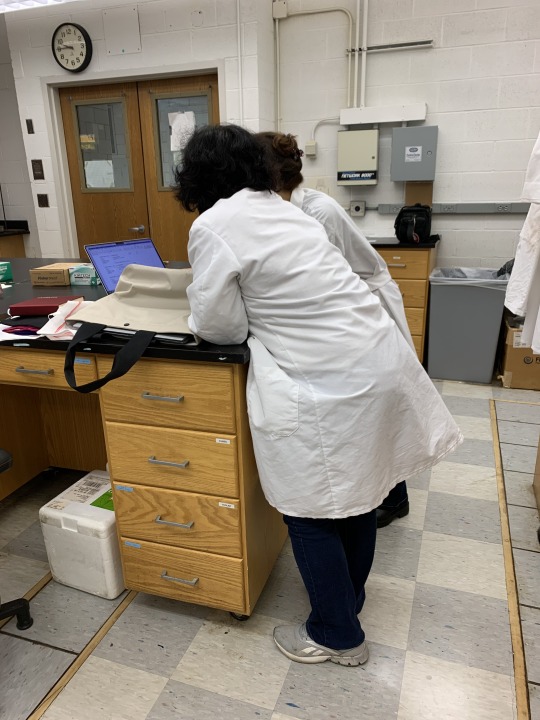
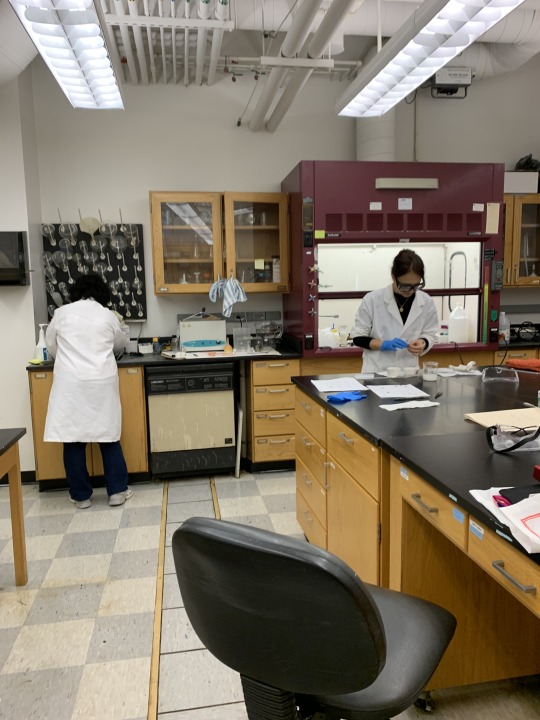
Then silver tablets will be dipped into the solution:
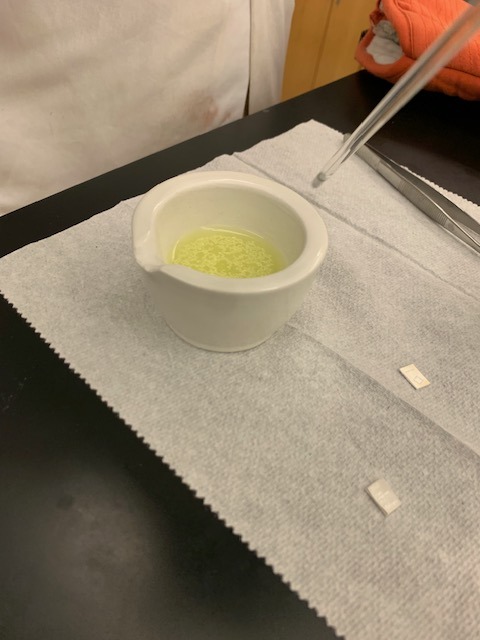
And turn gold!

Not *into* gold. That was not the plan. Hope you aren't disappointed.
If you thought the object of alchemy in those dark basements in Prague was turn to lead into gold, yeah me, too. And maybe it was, but the alchemy of the ancient Near East seems to have been more clear that transmutation wasn't on offer. After reading some of Maddalena's articles, I now know there were four main practices of alchemy back in the day: coloring silver gold, making a silver alloy that still looked like silver, coloring glass to look like precious stones, and dying wool purple without using those expensive snail shells from Tyre.
I talked about alchemy a lot (really, a lot, everyone was very patient) at a recent writing retreat. Erin Bow called it the Science of Knock Offs.
There are multiple ancient sources that say that this "holy and divine art" (hē hiera kai theia technē) was taught to mankind by fallen angels who were sharing the secrets of heaven. I know it seems ridiculous that an all knowing divine being is going to focus on the Secret Science of Knock Offs, but the more I I think about it, the more I can see it.
ARMUMAHEL: We will share with you the great mysteries of heaven!
MANKIND: . . .
ARMUMAHEL: I can save you some money on purple dye.
MANKIND: YAY!
SAMYAZA: So how did the secret sharing go today, Armumahel? Did they ask about the language of birds? The control over monsters of the deep?
ARMUMAHEL: I told'em how to make glass marbles look like sapphires.
SAMYAZA: You do know Enoch is writing all this down. His book is going to be stuck in the apocrypha and we're going to be laughing stocks.
ARMUMAHEL: I promised to tell them tomorrow how to turn silver gold.
SAMYAZA: Ah! Transmutation of matter! That's a good one!
ARMUMAHEL: No, not transmutation. They just want the silver bowls on the alter to be yellow and shiny.
SAMYAZA: . . .

My shiny yellow tablet. : )
250 notes
·
View notes
Text
𝖀𝖓𝖉𝖊𝖗𝖘𝖙𝖆𝖓𝖉𝖎𝖓𝖌 & 𝖀𝖘𝖎𝖓𝖌 𝕸𝖆𝖌𝖎𝖈𝖆𝖑 𝕮𝖔𝖗𝖗𝖊𝖘𝖕𝖔𝖓𝖉𝖊𝖓𝖈𝖊𝖘
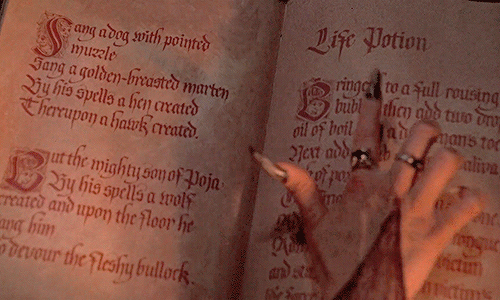
Witchcraft magical correspondences refer to the associations made between various objects, substances, times, and events with specific magical effects or purposes. These correspondences have deep historical roots and derive from a blend of multiple sources, including ancient alchemy, early science, cultural symbolism, religious beliefs, and intentionality.
Ancient Alchemy
Alchemy, the precursor to modern chemistry, played a significant role in shaping magical correspondences. Alchemists sought to understand the mysteries of matter and the transformation of substances, often imbuing their experiments with spiritual and mystical significance. For example, the seven classical planets (Sun, Moon, Mercury, Venus, Mars, Jupiter, and Saturn) were associated with specific metals (gold, silver, mercury, copper, iron, tin, and lead, respectively). These associations were believed to reflect the planets’ influences on earthly matters and human affairs. Alchemical texts also explored the relationships between colors, elements, and spiritual principles, influencing the development of magical correspondences in witchcraft.
Ancient alchemy holds a significant place in the history of science, philosophy, and mystical traditions, influencing various fields and practices, including witchcraft. The importance of ancient alchemy can be understood through its contributions to the development of modern science, its philosophical and spiritual dimensions, and its enduring influence on magical and esoteric traditions.
The Great Work (Magnum Opus): Central to alchemy is the concept of the Great Work, which symbolizes the alchemist’s quest for spiritual and material transformation. This process involves the purification and perfection of substances, often mirroring the alchemist’s inner spiritual journey toward enlightenment and self-realization.
Symbolism and Allegory: Alchemical texts are rich in symbolism and allegory, using metaphors to convey complex philosophical and spiritual concepts. Symbols such as the philosopher’s stone, the ouroboros (a serpent eating its own tail), and the four elements (earth, air, fire, water) encapsulate profound ideas about the nature of reality, transformation, and the interconnectedness of all things.
Hermetic Tradition: Alchemy is closely associated with Hermeticism, a philosophical and spiritual tradition based on the writings attributed to Hermes Trismegistus. Hermetic principles, such as “As above, so below” and the unity of opposites, permeate alchemical thought and emphasize the correspondence between the macrocosm (the universe) and the microcosm (the individual).
Magical Correspondences: Alchemical principles and symbols have been integrated into various magical and esoteric traditions. The associations between planets, metals, and elements in alchemy have become foundational correspondences in many forms of magic and witchcraft.
Transmutation and Transformation: The alchemical goal of transmutation, particularly the transformation of base metals into gold, has a symbolic counterpart in magical practices. This idea of transformation is applied to personal growth, healing, and the manifestation of desires through magical means.
Ritual and Practice: Alchemical rituals, with their focus on purification, transformation, and the attainment of higher states of being, have influenced the structure and content of magical rituals. The use of specific substances, tools, and processes in alchemy has parallels in magical workings, emphasizing the transformation of both the practitioner and the environment.
Alchemy in the Renaissance: During the Renaissance, alchemy experienced a revival as scholars and practitioners sought to integrate ancient wisdom with emerging scientific knowledge. Figures like Paracelsus and John Dee contributed to the development of alchemical thought, blending it with medicine, astrology, and early chemistry.
Psychological Alchemy: In the 20th century, Carl Jung, a prominent psychologist, explored alchemy as a metaphor for psychological processes. Jung’s interpretation of alchemical symbolism as representing the individuation process—the integration of the conscious and unconscious mind—brought new insights into the relevance of alchemy for personal development and psychotherapy.
Contemporary Practice: Today, alchemy continues to inspire both scientific inquiry and spiritual exploration. Modern alchemists, both literal and symbolic, seek to uncover the hidden principles of transformation in nature and the self. The enduring appeal of alchemy lies in its holistic approach, integrating material, psychological, and spiritual dimensions of existence.
Early Science and Natural Philosophy
Early scientific observations and natural philosophy also contributed to the development of magical correspondences. Ancient and medieval scholars often categorized the natural world into elements (earth, air, fire, and water) and humors (blood, phlegm, yellow bile, and black bile), each with specific qualities and effects. These classifications were used to explain natural phenomena and human health, and they found their way into magical practices. For instance, herbs and stones were categorized based on their perceived elemental qualities, and their uses in magic were aligned with these characteristics.
Cultural Symbolism and Mythology
Cultural symbolism and mythology provided another rich source of correspondences. Different cultures imbued animals, plants, colors, and objects with symbolic meanings based on their myths, legends, and folklore. For instance, the oak tree was sacred to many ancient European cultures and associated with strength and protection, while the owl, often seen as a symbol of wisdom in Greek mythology, became associated with knowledge and divination in magical practices. These symbolic associations were passed down through generations and integrated into the magical correspondences of witchcraft.
Religious Beliefs and Practices
Religious beliefs and practices also shaped magical correspondences. Many magical traditions borrowed from the rituals and symbols of dominant religious practices in their regions. In Western Europe, for instance, Christian symbols and saints were often syncretized with older pagan deities and symbols. The use of incense, candles, and specific prayers or chants in magic often mirrors religious rituals, emphasizing the importance of intentionality and spiritual alignment in magical workings.
Intentionality and Personal Experience
The role of intention and personal experience cannot be overlooked in the development of magical correspondences. Practitioners of witchcraft often develop their own associations based on personal experiences, intuition, and the results of their magical workings. This process of individual experimentation and reflection allows for a dynamic and evolving system of correspondences that can vary between different traditions and practitioners. The intention behind the use of a correspondence is believed to be a critical factor in its effectiveness, highlighting the importance of the practitioner’s focus and purpose.
Synthesis and Evolution
Over time, these diverse influences have synthesized into the rich tapestry of magical correspondences used in witchcraft today. Texts such as the “Key of Solomon,” “The Picatrix,” and various grimoires have codified many of these correspondences, while modern practitioners continue to adapt and expand them based on contemporary understanding and practice. The integration of psychological insights, ecological awareness, and cross-cultural exchanges in the modern era further enriches the system of correspondences, making it a living and evolving aspect of witchcraft.
No single person or group decided these correspondences; rather, they evolved organically through the accumulated wisdom and practices of different cultures. Here are some key influences and sources:
Ancient Civilizations
Egyptians: Ancient Egyptian priests and magicians developed extensive knowledge of correspondences. They believed that everything in nature was interconnected and that specific plants, stones, and symbols held particular powers. Their practices were recorded in texts like the Ebers Papyrus and various temple inscriptions.
Greeks and Romans: The Greeks and Romans contributed significantly to the development of correspondences, particularly through the work of philosophers and physicians like Hippocrates, Theophrastus, and Pliny the Elder. Their writings on herbalism, astrology, and natural philosophy helped establish connections between natural elements and their supposed properties.
Celts: The Druids of the Celtic world had a deep understanding of nature and used various plants, trees, and natural phenomena in their spiritual and magical practices. Their knowledge was passed down orally and later recorded by Christian monks.
Medieval and Renaissance Europe
Medieval Herbalists and Alchemists: During the Middle Ages, herbalists and alchemists in Europe studied ancient texts and conducted their own experiments. They documented the properties of plants, minerals, and metals in texts like the “Materia Medica” and various grimoires. Alchemical traditions, which sought to transform base materials into higher forms, also contributed to the understanding of correspondences.
Astrology: Medieval and Renaissance astrologers played a significant role in establishing correspondences, particularly through the association of planets with specific days of the week, metals, and plants. The writings of figures like Ptolemy and later Renaissance magicians like Cornelius Agrippa and Paracelsus were influential in this regard.
Eastern Traditions
Chinese Medicine and Taoism: Traditional Chinese medicine and Taoist practices developed a system of correspondences based on the Five Elements (Wood, Fire, Earth, Metal, Water). These elements were connected to various aspects of life, including organs, emotions, seasons, and directions. The “Huangdi Neijing,” an ancient Chinese medical text, is a key source of this knowledge.
Indian Ayurveda and Hinduism: Ayurvedic medicine and Hindu spiritual practices established correspondences between herbs, gems, times of day, and deities. Texts like the “Atharva Veda” and various Ayurvedic treatises documented these associations.
Modern Influences
Grimoires and Occult Literature: From the Renaissance onward, numerous grimoires (books of magic) compiled and expanded upon earlier correspondences. Notable examples include the “Key of Solomon,” “The Lesser Key of Solomon,” and “The Picatrix.” These texts were influential in shaping modern Western magical practices.
The Golden Dawn and Modern Witchcraft: In the late 19th and early 20th centuries, the Hermetic Order of the Golden Dawn and similar occult organizations synthesized various magical traditions, creating detailed systems of correspondences. Influential figures like Aleister Crowley and Dion Fortune contributed to this synthesis. In the mid-20th century, Gerald Gardner and others who founded modern Wicca drew upon these traditions, further popularizing and systematizing magical correspondences.
Conclusion
Magical correspondences are the result of centuries of observation, experimentation, and synthesis by various cultures and traditions. They were not decided by any single individual or group but evolved over time through the collective wisdom of countless practitioners. Today, they continue to be an essential part of many magical and spiritual practices, providing a framework for understanding and working with the interconnectedness of the natural and spiritual worlds.
#divination#free tarot readings#spirituality#witchblr#tarot#witch#witchcraft#high priestess house#witch community#astrology#eclectic witch#correspondences#witch history#witches of tumblr#occult history#occultism#occult#witchy vibes#witchcore#witch aesthetic#baby witch#witches#witchcraft 101#moon witch#witchy#alchemy#psychology#herbalism#herbalmedicine#alchemist
476 notes
·
View notes
Text

i developed a heavy association of the breeze with copper and you wont believe who i heavily associate with copper bc of s9 (mumbo, its mumbo)
(design heavily stolen from @applestruda btw)
2K notes
·
View notes
Text


Candles' Colours & Associations ❁ཻུ۪۪ ━
‧₊˚. : · •. * • ˚ . · * ✶ : · • * ˚ ✵
Candle magic, often referred to as "magick" (a common alternate spelling), offers an accessible and budget-friendly approach to spiritual practices. For centuries, people have incorporated candle rituals into their spiritual routines, making it an integral part of diverse traditions. Candles play a versatile role in various occasions like weddings, birthdays, spells, honouring deities and numerous other celebrations and rituals.
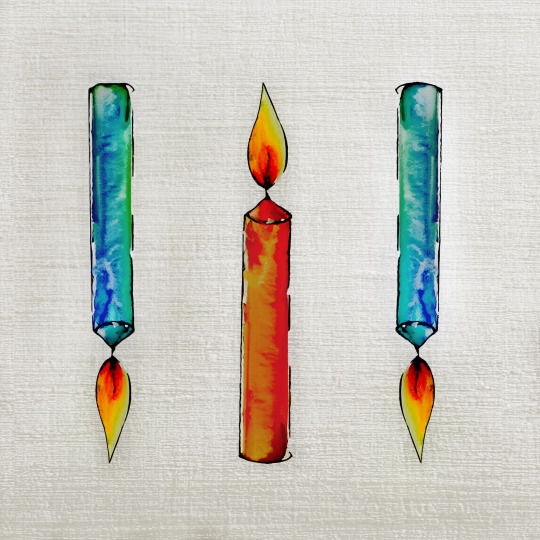

𖤣𖥧˚ Candle Colour Associations
Each candle colour is associated with distinct energies, intentions, and vibrations. Understanding these associations is essential for crafting meaningful candle rituals. Candles add rather than subtract to your spells, although candles aren't always necessary and you can use any candle and associate your own meanings for them, but here are some common candle colour associations:
White: Purity, spirituality, banishing, cleansing, unveiling, healing, truth, balance, innocence, clarity, peace, new beginnings, and illumination. It represents divine light and is often used for cleansing and invoking spiritual protection.
Red: Passion, love, courage, fire, lust, anger, revenge, sex, power, survival, change, action, assertiveness, and strength. Red candles are employed for matters of the heart, to enhance energy, and ignite motivation.
Orange: Success, enthusiasm, curiosity, change, opportunities, simulation, courage, and attraction. Orange candles are used to stimulate creativity and bring positive energy into endeavors.
Yellow: Creativity, joy, motivation, positivity, relieving negativity, energy, happiness, and clarity. Yellow candles can enhance mental clarity, increase focus, and bring a sense of joy and optimism.
Green: Growth, abundance, fertility, wealth, nature, naivety, healing, and prosperity. Green candles are used for attracting financial well-being and promoting healing and renewal.
Blue: Peace, healing, recollection, psychic growth, justice, study, mental blocks, guidance, calm, honesty, harmony, intuition, and communication. Blue candles aid in deepening meditation, enhancing psychic abilities, and fostering emotional balance.
Purple: Spirituality, wisdom, divination, and higher consciousness. Purple candles are associated with spiritual awakening and seeking inner wisdom.
Pink: Love (self-love), friendship, nurturing, and harmony. Pink candles are often used in rituals focused on self-love, compassion, and nurturing relationships.
Grey: Transmutation, patience, mediating, neutralizing, balance, stability, study, calm, balance, developing psychic abilities, and wisdom. Grey candles are useful when contemplating complex issues and can neutralize negative influences.
Brown: Wisdom, grounding, tenacity, perseverance, stability, rooted, security, woods, family, animals, pets, earth, material items, practicality, rediscovery, reconnection, and balance. Brown candles serve a dual purpose: safeguarding pets and family members, as well as facilitating reconnection with friends and loved ones.
Black: Protection, banishing, endings, absorbing, safety, binding, exorcism, release, death, healing, loss, and releasing negativity. Black candles are used for purification and breaking negative patterns. Some people will also use black candles for revenge spells (white too) or breaking hexes.
𖤣𖥧˚ Metallic Candle Colour Associations
Gold: Abundance, wealth, spiritual illumination, success, good fortune, happiness, ambition, luck, and the sun. Gold candles are used to invoke prosperity, celebrate achievements, and attract positive energies.
Silver: Intuition, self-reflection, perception, awareness, defend, send-back energy, protection, and emotional balance. Silver candles are employed for enhancing psychic abilities, connecting with lunar energies, and invoking the divine feminine.
Copper: Healing, vitality, emotions, autumn, new ideas, relaxation, combining, coming together, and energy balancing. Copper candles are utilized to promote physical healing, boost energy levels, and restore equilibrium.
Bronze: Grounding, strength, autumn, foundation, and courage. Bronze candles are associated with stability, courage, and protection during challenging times.

Final ❁ཻུ۪۪ ━
‧₊˚. : · •. * • ˚ . · * ✶ : · • * ˚ ✵
Feel free to reach out to me if you're interested in exploring different candle colours or their associations. You can send me a message directly, drop a note in my inbox, or share your thoughts in the comments, and I'll be happy to expand on the topic!
#paganblr#candles#candle associations#candle magic#magick#witchblr#spells#candle colours#beginner witch#pagan#eclectic witch#eclectic pagan#pagan blog#witch blog#spirituality#paganism#witch community#pagan community#meanings & associations
549 notes
·
View notes
Text
More Art-Related Vocabulary

Abstract Expressionist: An artistic movement of the mid-20th century emphasizing an artist’s freedom to express attitudes and emotions, usually through nonrealistic means.
Age of Exploration (also, Age of Discovery): From the early 15th century to the early 17th century, European ships traveled around the world in search of new trading routes, lands, and partners to supply an ever-growing European market.
Albumen silver print: A photograph made using a process that was prevalent until the 1890s. The paper is coated with albumen (egg whites), and the image is created using a solution of silver salts.
Brayer: A hand roller used for applying ink to relief printing blocks or occasionally for the direct application of paint or ink to a surface.
Caricature: A representation in either literature or visual art that includes a ridiculous distortion or exaggeration of body parts or physical characteristics to create a comic or gross imitation.
Ceramics: Vessels of clay made by using a variety of shaping techniques and then hardening or firing the clay with heat at a high temperature.
Chasing: A term encompassing two processes in metalworking: (a) modeling decorative patterns on a hand-shaped sheet-metal surface using punches applied to the front, and (b) finishing and refining a cast sculpture.
Classical: Describes a prime example of quality or “ideal” beauty. It often refers to the culture, art, literature, or ideals of the ancient Greek or Roman world, especially that of Greece in the 4th and 5th centuries B.C.
Collage: An art form and technique in which pre-existing materials or objects are arranged and attached as part of a two-dimensional surface.
Color palette: (a) A set of colors that makes up an image or animation, and (b) the group of colors available to be used to create an image.
Composition: The process of arranging artistic elements into specific relationships to create an art object.
Daguerreotype: An early method of photography produced on a silver plate or a silver-covered copper plate made sensitive to light.
Exoticism: Fascination with and exploration and representation of unfamiliar cultures and customs through the lens of a European way of thinking, especially in the 19th century.
Expressionism: A style of art inspired by an artist’s subjective feelings rather than objective or realistic depictions based on observation. Expressionism as a movement is mainly associated with early 20th century German artists interested in exploring the spiritual and emotional aspects of human existence.
Gelatin silver print: A photograph made through a chemical process in which a negative is printed on a surface coated with an emulsion of gelatin (an animal protein) containing light-sensitive silver salts.
Illuminated manuscript: Comes from the Latin words illuminare (to throw light upon, lighten, or brighten), manus (hand), and scriptus from the verb scribere (to write). A handwritten book, usually made from specially prepared animal skins, in which richly colored and sometimes gilded decorations, such as borders and illustrations, accompany the text.
Illuminator: A craftsman or artist who specializes in the art of painting and adorning manuscripts with decorations.
Impressionist: Referring to the style or theories of Impressionism, a theory or practice in painting in which objects are depicted by applying dabs or strokes of primary unmixed colors in order to evoke reflected light. Impressionism was developed by French painters in the late 19th century.
Inking plate: A flat surface used for rolling ink out in preparation for applying ink to a plate or block.
Inscription: A historical, religious, or other kind of record that is cut, impressed, painted, or written on stone, brick, metal, or other hard surface.
Source Art Vocabulary pt. 1
More: Word Lists
#art related#word list#photography#dark academia#writing reference#spilled ink#writeblr#literature#writers on tumblr#writing prompt#poetry#poets on tumblr#history#studyblr#creative writing#writing inspiration#writing inspo#writing ideas#art#konstantin somov#rainbow#nature#art vocab#writing resources
111 notes
·
View notes
Text
DAY 5974
Jalsa, Mumbai June 26/27, 2024 Wed/Thu 12:56 am
🪔 ,
June 27 .. birthday wishes to : Ef Ravi Patel .. Ef Diyansh Kumbhat from Chennai .. and .. Ef Ayush Mishra from Bilaspur .. 🙏🏻❤️🚩
💍 .. wedding anniversary greeting to : Ef Rajesh Kejriwal from Kolkata .. completing 35 years of togetherness .. on June 26 .. our wishes and more .. 💐🙏🏻❤️🚩
..
Birthday - EF - Ravi Patel Thursday, 27 June our wishes for this day and the best ever .. love ❤️
Resistance .. its many forms and values and dimensions and usage .. so it became urgently important to apprise the self of it from sources ..
"Resistance is a multifaceted concept, encompassing physical, psychological, social, and political dimensions. Its definition and application can vary significantly depending on the context in which it is considered. At its core, resistance involves the act of opposing, withstanding, or striving against some force or condition. This broad definition can be applied to various fields, including physics, medicine, psychology, and social movements.
In physics, resistance is a measure of the opposition to the flow of electric current in a conductor. It is quantified by the unit ohm and symbolized by the Greek letter omega (Ω). The resistance of a conductor depends on its material, length, cross-sectional area, and temperature. For instance, materials like copper and aluminum have low resistance and are therefore good conductors, whereas materials like rubber and glass have high resistance and are good insulators. Ohm's Law, a fundamental principle in electrical engineering, states that the current flowing through a conductor between two points is directly proportional to the voltage across the two points and inversely proportional to the resistance. This relationship is crucial in designing electrical circuits and understanding their behavior.
In medicine, resistance often refers to the ability of microorganisms, such as bacteria and viruses, to withstand the effects of drugs that are intended to kill or weaken them. Antibiotic resistance is a significant public health concern, as it makes infections harder to treat, leading to longer hospital stays, higher medical costs, and increased mortality. Resistance can develop through various mechanisms, such as genetic mutations or the acquisition of resistance genes from other bacteria. The overuse and misuse of antibiotics in humans and animals accelerate this process, making it imperative to use these medications judiciously and to develop new treatments.
Psychologically, resistance can manifest as a reluctance or refusal to accept certain thoughts, feelings, or behaviors. This concept is particularly relevant in therapy and counseling, where clients may resist discussing painful or traumatic experiences. This resistance can be conscious or unconscious and can hinder the therapeutic process. Understanding and addressing resistance is crucial for therapists, as it can provide insights into the client's internal conflicts and defenses. Techniques such as building a strong therapeutic alliance, using motivational interviewing, and gradually exposing clients to difficult topics can help in overcoming resistance.
In social and political contexts, resistance is often associated with efforts to oppose and challenge established power structures, policies, or social norms. Throughout history, resistance movements have played pivotal roles in advocating for social change and justice. Examples include the civil rights movement in the United States, the anti-apartheid struggle in South Africa, and the women's suffrage movement. These movements often involve a combination of nonviolent protest, civil disobedience, and sometimes armed struggle. The success of these movements typically depends on various factors, including leadership, organization, public support, and the ability to adapt to changing circumstances.
In contemporary times, resistance continues to be a vital force in addressing issues such as climate change, systemic racism, and economic inequality. Activists and grassroots organizations worldwide are mobilizing to resist policies and practices that they perceive as unjust or harmful. Social media and digital communication have transformed the landscape of resistance, enabling rapid dissemination of information, coordination of actions, and amplification of marginalized voices.
Resistance, in its many forms, is an essential aspect of human experience and societal development. Whether in the realm of science, health, psychology, or social justice, resistance challenges the status quo and fosters progress. It embodies the struggle for survival, dignity, and betterment, reflecting the resilience and determination inherent in individuals and communities. As such, understanding and engaging with the concept of resistance is crucial for addressing the complex challenges of our world. "
... and at times the sources do not even address the most common of them all in the resistance ..
It be the pen and paper writing ..
When the pen has a resistance to the paper quality it is being written on the writing experience is determined as good bad or average ..
When the holding posture of the pen is conveniently comfortable to write, it produces the quality of writing exhibited ..
When the nib and flow of the ink on the pen is of desired like , the paper may be of the best resistance quality, the writing shall never be of the desired ..

paper same .. nib different , pen different .. sign same , but all different in form and appearance ..
GN 😴

Amitabh Bachchan
94 notes
·
View notes
Note
Hey I was wondering— materials like gold and silver actually do exist in this setting, right? Not just as remnants of sender beasts? Does the reputation of the caste influence people’s association with the real metal? Like gold not being as valuable as silver? Or copper being treated as more special than both of them?
That's a good question! Both materials do exist in their base forms but these all are derived from their First forms, so there's a perceived worthlessness to "precious metals" that have lost their pymaric use. Neither regular gold nor regular silver are considered especially valuable, even if they are used for ornamentation. You take a bunch of Earth gold into a pawn shop and they won't even want it. Go take it to the jeweler, they'll say, and you do, and he scowls at it and says you can't even enchant any of it, I'll give you a buck fitty.
First Materials are the precious materials, but it's an interesting situation because they are not only valuable, but they're crucial to the formation of pymarics. They can't be turned into baubles or minted into money. They can be stockpiled and used to measure wealth that way, but it's a volatile standard since FMs are being exhausted and new supplies discovered all the time.
ANYWAY, yes, silver is more valuable than gold when it comes to coinage, but this is because First Silver is one of the strongest First Materials. Sem coins are all plated tin or steel, but they're still referred to as silver, gold, or copper except in Alderode, where they have specific Tainish names for each - doubtlessly developed due to caste connotation :)
I'm trying to remember those names. It was Barque, Fish, and something else, I used 'em in RP... bah, can't remember. I probably won't use them in the comic anyway, it's unnecessary complexity.
35 notes
·
View notes
Text

Panama marks 21 days of indefinite strike, amid repression and dialogue
Panama today marks 21 days of an indefinite national strike initiated by teachers in rejection of Law 462 of the Social Security Fund (CSS), amid police repression and disputes over dialogue
Panama today marks 21 days of an indefinite national strike initiated by teachers in protest of Law 462, the Social Security Fund (CSS), amid police repression and disputes over dialogue.
The general secretary of the Single Union of Workers in the Construction and Related Industries (Suntracs), Saúl Méndez, denounced the arrest of union leaders intended to intimidate the struggle against the agreement signed by the government and the United States that promotes the establishment of military bases.
The fight is also against the government's intention to reopen a copper mine in Donoso (Colón), despite a Supreme Court ruling ordering the closure of its operations, and in opposition to the construction of a reservoir on the Indio River for the Canal, against the will of the region's residents, he added.
The day before, the Panamanian Ministry of Education announced that it will withhold the salaries of teachers protesting Law 462, a measure deemed arbitrary by the groups.
Since April 23, public sector teachers have begun an indefinite strike, demanding the repeal of the law, which they believe harms workers and their families, privatizes CSS services, and hands over its funds to banks, while predicting miserable pensions—an unacceptable measure.
According to Fernando Ábrego, the secretary general of the Panamanian Teachers Association (Asoprof), the strike will continue despite the intimidation and retaliation by the government of José Raúl Mulino. He also announced that they will demand the resignation of Lucy Molinar, head of the Ministry of Education and Culture.
On another note, a government commission traveled to the western province of Bocas del Toro to speak with leaders of protesting grassroots organizations.
Protesters have been carrying out actions for more than three weeks, including road closures like those in the town of Changuinola and a work stoppage in the banana sector, which have seriously impacted the economy.
According to Chiquita, a subsidiary of the American company Chiquita Brands International, production had to be suspended on approximately three farms after losses totaling $10 million due to the strike.
The government delegation includes the Ministers of Commerce and Industry, Julio Moltó, and Labor and Workforce Development, Jackeline Muñoz, as well as the Director of the CSS, Dino Mon.
This first attempt to initiate talks with the protesters and ease the tense climate of confrontation comes despite the fact that President José Raúl Mulino, in his weekly press conference last Thursday, indicated that he would refuse to discuss the insurance policy and the agreement with Washington.
Translation by Walter Lippman
17 notes
·
View notes
Note
Curious what you'd say about Soap for the character ask game. You haven't really spoken about him as much as the others so I'm curious :O (id love to hear about every single character tho i wont lie to you but i have a feeling you'll get asked about those lol)
@nekrosmos asked for Soap too.
Honestly? There is unfortunately a reason. I lingered around fandom for a good few months before I got involved at all. I saw some behaviour from his fanbase that I didn't like and so I made the conscious choice that he's not a character I'd probably be creating much for. I love the art, happy to support creators, etc. Besides, there are so many delicious, delicious rarepairs to love and create for and plenty of gallant, productive, devoted Ghoapers.
He's quite compelling though, and I've got quite a few thoughts and headcanons, and I'm happy to write prompts with him. A few friends on Discord really love him and I like to create for them too, cause happy friends give me the fuzzies. So, you know, a story idea might grip me by the balls and I'll wack out a long form thing.
favorite thing about them
His journals.
Reading those finally gave me a connection with his character that I hadn't developed previously. But they really show how driven he is, how much he wants to be the best he can be, so he's not a burden, so he doesn't let anyone down. He's constantly striving to earn his place to the point that it kills him in the end.
I think he genuinely struggles with wanting to be liked (as part of 'earning his place'), and I think he is often too much for people. Ghost giving back as good as he gets is a comfortable relationship because the line for Ghost is way, way in the distance; Johnny doesn't have to worry like he does with 'normal' people. Neither of them is fuckin' normal.
Price giving him a chance would have been the first step towards the hero-style worship he has for him. "What? Me? Ye want... me? Aye, aye I will be the best fuckin' dog ye ever had, I will bite my own leg off for ye." Everything Soap does is to prove that Price didn't make a mistake. That he was a good investment. And Price, the sly fucker, knows it. He sees himself there.
least favorite thing about them
I wish they had given him a stronger accent and leaned more into that in the games. In fact, I wish that for all of them.
I also think that Soap has capacity to cause great harm without even realising it. Like, we get glimpses of it; he's nearly court-martialled for punching out a copper. In his single-minded pursuit of something, I reckon there could be a lot of collateral damage.
He lacks confidence but will cover it up by being an arsehole and doing arsehole things (such as smuggling a girl on base to impress The Guys). I say I like "least favourite"; I think this makes him compelling as a character. He's not all sunshine and rainbows. He's just as gritty, professional and flawed as the rest of 'em.
favorite line
"You sick bastard..."
"My kingdom for a suppressor..."
"Price?... This belongs to you, sir."
brOTP
Gaz & Soap
OTP
Uh... none really. Ghost/Soap?
nOTP
Don't have any strong feelings on any.
random headcanon
He's really bad at team sport. He showed no interest in any when he was growing up. Gym? Running? Swimming? Anything where the only competition is himself and his own limits? That's where Soap's head is.
unpopular opinion
Honestly? I don't know which of my opinions would be unpopular. Probably the 'not sunshine and rainbows' one, maybe?
song i associate with them
favorite picture of them

#johnny soap mactavish#cod#call of duty#dunno is this too negative for his tags?#let me know i guess
30 notes
·
View notes
Text
My favourite
✨fandom assigned animals✨
1. XBCrafted - Gaurdian
Firstly the style points? undeniable,
Second all the ocean monuments? Incredibly edible,
Thirdly mmmmmm fishman (heehee mermaid design)
2. Geminitay - Centaur/Deer?
Cryptid, mysterious, Magical
Elf!!!!!
Undeniably serves
3. Grian - Macaw/bird
Mmmm angst possibilities
He’s 100% accepted it at this point
Infected everyone associated with him with B I R D
4. Smallishbeans - ogre
It’s mostly the fact that he has done it too himself
The shrek skin is eternally ingrained in my psyche
You cannot run from your past 🫵
5. Pixlriffs - Phantom
I can explain-
First off, Imagine The Copper King with well maintained & protected wings, only takes them out from his cloak at night, can be EXTREMELY intimidating
Then The Archeologist, just going grey, wings tattered and torn, no longer prized, in fact seen as a memory of all that he’s lost, can’t fly without elytra, Can still be EXTREMELY intimidating when needed
Just the angst potential??? Mmmmm
Also I love the phantom assassin sm
I miss the copper king :(
6. Lizzie - Raven
Recent development (SL my beloved)
So so so sooooo much angst possibility,
I could write ESSAYS on her
Just let me out of my cage(a minor Gravity Falls side quest)
25 notes
·
View notes
Text

From e-waste to gold: A pathway to CO₂ sustainability
A Cornell-led research team has developed a method for extracting gold from electronics waste, then using the recovered precious metal as a catalyst for converting carbon dioxide (CO2), a greenhouse gas, to organic materials. The method could provide a sustainable use for some of the approximately 50 million tons of e-waste discarded each year, only 20% of which is recycled, according to Amin Zadehnazari, a postdoctoral researcher in the lab of Alireza Abbaspourrad, the Yongkeun Joh Associate Professor of Food Chemistry and Ingredient Technology in the College of Agriculture and Life Sciences. Zadehnazari synthesized a pair of vinyl-linked covalent organic frameworks (VCOFs) to remove gold ions and nanoparticles from circuit boards in discarded electronic devices. One of his VCOFs was shown to selectively capture 99.9% of the gold and very little of other metals, including nickel and copper, from the devices.
Read more.
#Materials Science#Science#Electronics#Waste#Carbon dioxide#Gold#Catalysts#Covalent organic frameworks#COFs#Cornell University
14 notes
·
View notes
Text









On 19th January 1736 James Watt, developer of the steam engine was born in Greenock.
Watt had little formal education due to poor health in his youth, but pottering about in his father's shop he developed an interest in trying to make things "work like clockwork".
In his late teens he went to London to learn to be a "mathematical and philosophical instrument maker", and when he returned to Glasgow he got a job making instruments with Glasgow University, who gave him accommodation and a workshop.
In 1763 John Anderson, who featured on last Monday's post, asked him to repair an early steam engine he had acquired. This early model, known as a Newcomen engine, was very inefficient. The cylinder (where the piston was) had to be heated when steam was admitted, and then gradually cooled again to condense the steam. This wasted a lot of time and fuel. Two years later, while wandering aimlessly through Glasgow Green, Watt hit upon the idea of condensing the steam in a separate vessel. This removed the need for heating and cooling, making the engine faster, safer, and more fuel-efficient. A stone in Glasgow Green marks this spot, where the industrial revolution really began. (Later, in 1778 Watt presented Anderson with a micrometer he had designed and made, as a gesture of thanks.)
Watt went into business with Matthew Boulton, a Birmingham engineer, producing engines based on this new approach. Engineers from all the industrialised countries flocked to see their factories.
Watt's engines were initially used for pumping water from Cornish tin and copper mines. Later, the new cotton mills, which had been built near fast-flowing rivers to take advantage of water power, almost all switched to steam. Gradually, mills began to move toward the centres of population. At first, steam power was used mainly for spinning, but eventually weaving was also powered by steam engine. By 1819, the year of Watt's death, there were 18 steam weaving factories in Glasgow, with 2800 looms. (This was excellent news for factory owners, but hundreds of unemployed handloom weavers were not so enthused.) The increased power-to-weight ratio of the new engines also permitted their use for marine propulsion - in 1788 a steam-powered catamaran was taken across Dalswinton loch by William Symington.
Despite his success, Watt was a rather insecure and jealous man, who did not like others having their own ideas. When one employee of the company, a man named William Murdoch, experimented with high pressure steam engines, Watt discouraged him from patenting and continuing his work, even though his engines were potentially much better and smaller than the ones Watt himself had invented. Murdoch never patented his design, and returned to fixing Watt's own engines. (However, Murdoch did make another important contribution, to gas lighting.)
Apart from his steam research, which he originally carried out in the grounds of Kinneil House near Linlithgow, Watt was involved in many other projects. He solved the problem of how to convert the up-and-down piston movement to rotary movement (so that engines could power looms, bellows, and other mechanical devices), he created the term "horsepower", and he also invented the rev. counter, a machine for copying sculpture, and a letter copying press (a very early photocopier!).
When Watt retired in 1800, he had become a very rich man.
In 1882, 63 years after Watt's death, the British Association gave his name to the unit of electrical power - and today James Watt's name is to be found written on almost every light-bulb in the world.
Among the pics is a reconstruction of his workshop in Heathfield Birmingham.
11 notes
·
View notes
Text

Igbo-Ukwu Archaeology
Glass production: Igbo-Ukwu has one of the oldest glass productions in West Africa. The archeology of Igbo-Ukwu had over 600 prestige objects including complex cast copper-alloy sculptures and more than 165,000 glass and carnelian beads. The most common glass among the 138 analytical results for Igbo-Ukwu beads is soda-lime glass produced using plant ash.Glass beads from Igbo-Ukwu
Igbo-Ukwu is a historically significant archaeological site located in southeastern Nigeria, in what is now Anambra State. The site is renowned for its remarkable discoveries of ancient artifacts that date back to the 9th and 10th centuries AD. The archaeological findings at Igbo-Ukwu have provided valuable insights into the early history and cultural achievements of the Igbo people and their interactions with other civilizations in the region. The artifacts may be associated with the traditional Kingdom of Nri and its priest-king, the Eze Nri.
The significance of Igbo-Ukwu lies in the following aspects: Sophisticated Artifacts: The excavations at Igbo-Ukwu revealed a collection of highly sophisticated and elaborately crafted artifacts, including intricately designed bronze, copper, and iron objects. These artifacts demonstrate the advanced metallurgical skills of the ancient Igbo people and their ability to work with various metals.
The Igbo-Ukwu artifacts predate certain other well-known Nigerian bronze sculpture traditions such as those of Ife and the Benin Kingdom and have contributed to our understanding of the development of metallurgical techniques in Africa.
Cultural Exchange and Trade: The presence of exotic materials like glass beads and imported ceramics at the Igbo-Ukwu site suggests that the people of Igbo-Ukwu were engaged in trade and had connections with other cultures and civilizations, both within and outside of Africa.
Evidence of Social Complexity: The intricate and finely crafted artifacts found at Igbo-Ukwu suggest the existence of a sophisticated and socially complex society. The level of craftsmanship and the variety of artifacts indicate the presence of skilled artisans and a hierarchical social structure.
Influence on Igbo Art and Culture: The artifacts discovered at Igbo-Ukwu have had a profound impact on the understanding and appreciation of Igbo art and culture. They have inspired contemporary Igbo artists and craftsmen and contributed to a sense of cultural identity and heritage.
Recognition of African Achievements: The discoveries at Igbo-Ukwu challenged the outdated notion of Africa as a continent with no significant history or cultural achievements. The site's findings have demonstrated the richness and complexity of ancient African civilizations. The archaeological site of Igbo-Ukwu was first discovered in 1939 when a group of villagers accidentally came across the artifacts while digging a trench. Subsequent excavations conducted in the 1950s and 1970s uncovered a wealth of cultural treasures. The Igbo-Ukwu artifacts are now housed in various museums, including the Nigerian National Museum in Lagos.
Overall, Igbo-Ukwu remains a vital archaeological site that continues to contribute to our understanding of ancient African civilizations and their contributions to human history. 9th Century Igbo-Ukwu face pendantDouble egg pendant, leaded bronze, 9th-10th century, unearthed in Igbo Ukwu, AnambraBronze ornamental staff head, 9th century, Igbo-Ukwu
Glass production: Igbo-Ukwu has one of the oldest glass productions in West Africa. The archeology of Igbo-Ukwu had over 600 prestige objects including complex cast copper-alloy sculptures and more than 165,000 glass and carnelian beads. The most common glass among the 138 analytical results for Igbo-Ukwu beads is soda-lime glass produced using plant ash.
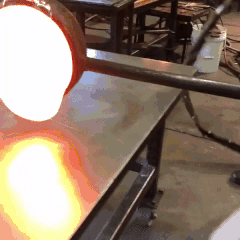
#african#afrakan#kemetic dreams#africans#brownskin#afrakans#brown skin#african culture#igbo#ukwu#anambra#west africa#igbo culture#igbo history#afrakan spirituality
59 notes
·
View notes
Text
Monday Musings: Copper and Your Health
Did you know that copper is a mineral that we need in our bodies? In fact, there are several metals we need to live healthy lives. What exactly do we need copper for? A few things actually. It is needed for the normal growth and development of human fetuses, infants and children.

In adults, it is necessary for the growth, development and maintenance of bone, connective tissue, brain, heart and many other body organs.

Copper is involved in the formation of red blood cells, the absorption and utilization of iron, and the synthesis and release of life-sustaining proteins and enzymes. These enzymes produce cellular energy and regulate nerve transmission, blood clotting and oxygen transport.
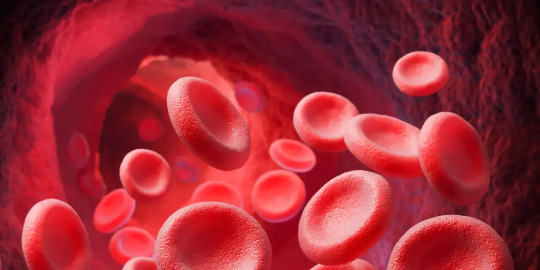
Copper is also known to stimulate the immune system, help repair injured tissues and promote healing. Copper has been shown to help neutralize "free radicals," which can cause severe damage to cells.

Despite all its uses, we only need about .9 mg of copper a day. Crazy right?
Where do I get copper in my diet? Copper-rich foods include grains, nuts and seeds, organ meats such as liver and kidneys, shellfish, dried fruits, legume vegetables like string beans and potatoes, chicken and some unexpected and delightful sources such as cocoa and chocolate.
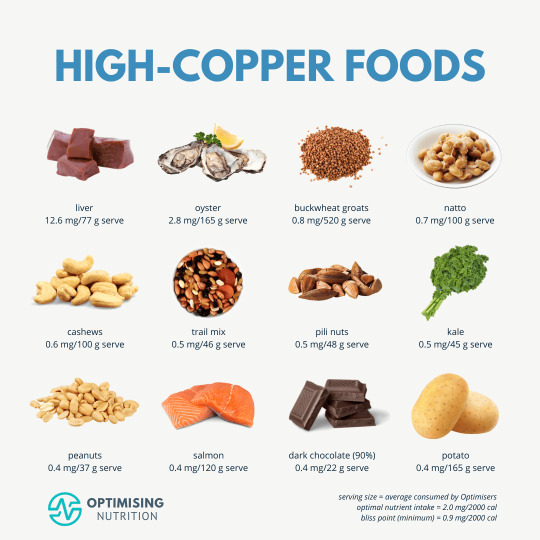
I don't know about you, but several of those are definitely in my diet.
Okay, next question, what happens if I don't get enough copper in my diet? A deficiency in copper is one factor leading to an increased risk of developing high cholesterol levels and coronary heart disease in humans. Copper deficiencies are also associated with premature births, chronic diarrhea and stomach diseases.

But of course, there are also risks if you consume too much copper too. It can cause nausea but thankfully, it's really hard to hit toxic levels of copper. Just don't go around eating copper wire and you should be fine.
The last fun fact I have for you is that there are clinical trials in effect right now to see if frequently touched surfaces and air ventilation systems in hospitals made out of copper or copper alloys can help stem bacterial infections in hospitals. Copper has some antimicrobial abilities and they are hoping it can stop infections of deadly diseases like MRSA.

Initial studies at the University of Southampton, UK, and tests subsequently performed at ATS-Labs in Eagan, Minnesota, for the EPA show that copper-base alloys containing 65% or more copper are effective against:
Methicillin-resistant Staphylococcus aureus (MRSA)
Staphylococcus aureus
Vancomycin-resistant Enterococcus faecalis (VRE)
Enterobacter aerogenes
Escherichia coli O157:H7 and
Pseudomonas aeruginosa.
Wild stuff, am I right? Who knew copper could be so useful outside of conducting electricity? Hope you enjoyed today's musings. Tune in tomorrow for one last trivia on copper before December is upon us! (I can't believe it's almost December. What happened to November?) Fossilize you later!
#fun facts#science#mineralogy#science education#copper#copper and health#biology#microbiology#I think copper has been used in all the sciences
10 notes
·
View notes
Text

A 4,000-Year-Old Dagger Discovered in Poland
A copper dagger more than 4,000 years old was found in a forest near the town of Jarosław on the San River in south-eastern Poland. This discovery is the oldest dagger made of metal found in the Podkarpackie Voivodeship.
In the 3rd millennium BC, objects made of copper were extremely rare in the area, Dr Elżbieta Sieradzka-Burghardt, an archaeologist from the Jarosław museum, told PAP.
This valuable object, dating back over 4,000 years, was discovered last November by Piotr Gorlach of the Jarosław Historical and Exploration Association, who – with the permission of the Podkarpacie Regional Historical Monument Conservator in Przemyśl – conducted a search with a metal detector in the forests in the area of the Jarosław Forest Inspectorate, near the village of Korzenica.
“I had already finished my search for the day. When I returned to the car, I left the detector on out of habit. At some point, there was a signal. When I was digging up the forest floor, I saw a flat metal object covered with a green patina. I quickly realized that I was dealing with something much older than the military items from World War I and II that I was looking for in this area,” Gorlach said.
Archaeologists from the Museum in Jarosław Orsetti House identified the artifact as an extremely rare 4,000-year-old dagger. The ancient weapon was made of copper and measured just over 4 inches (10,5 cm) in length.
According to archaeologist Dr. Marcin Burghardt from the Jarosław Museum, the dagger discovered in Korzenica can be dated to the second half of the third millennium BC.
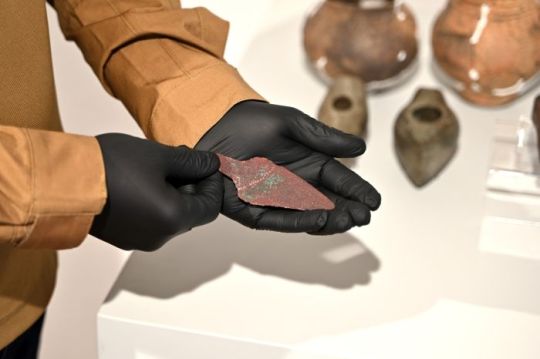
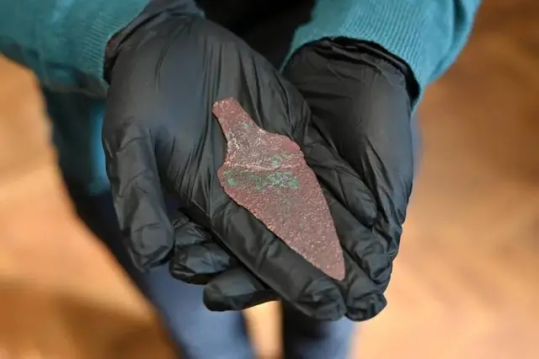
“In Polish lands, this is a period of enormous changes related to, among others, with a change in the main raw materials for the production of tools. Instead of flint tools commonly used in the Stone Age, more and more metal products appear, heralding the transition to the next period – the Bronze Age,” noted Dr. Burghardt.
In contrast, the now-discovered dagger from Korzenica – as noted by Dr Elżbieta Sieradzka-Burghardt, an archaeologist from the Jarosław museum – was not cast in bronze, but is made of copper.
“So it predates the development of bronze metallurgy,” the archaeologist noted. “In the third millennium BC, objects made of copper were extremely rare, so only people of the highest social status could afford them. There is rather no doubt that the dagger is not a local product,” Dr Burghardt-Sieradzka added.
During this period, metal products were imported from modern-day Ukraine or Hungary and only available to elites who could afford them. Links to the ancient weapon’s origin will be determined in the future through special metallurgical analysis.
By Leman Altuntaş.
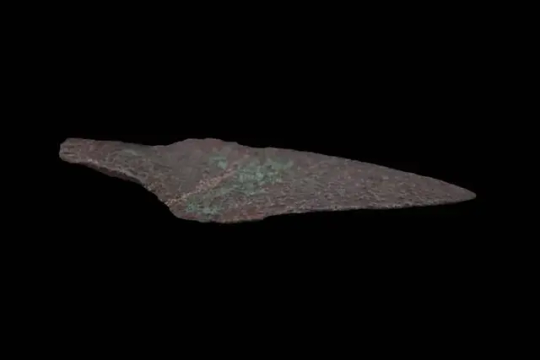
#A 4000-Year-Old Dagger Discovered in Poland#Jarosław#metal detecting#ancient artifacts#archeology#archeolgst#history#history news#ancient history#ancient culture#ancient civilizations
52 notes
·
View notes